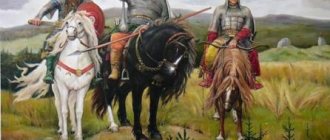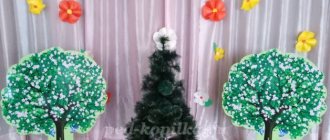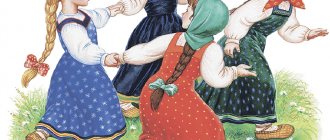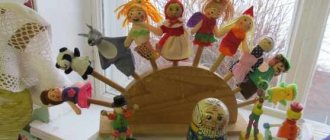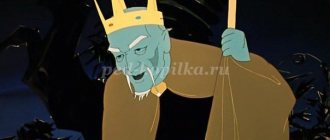Lesson summary on art “Russian heroes”. Project task “Bogatyrs of the Russian Land.”
Teacher: But what does our stone show?
shows: if you go straight, you will end up in an art studio, if you go to the left, you will end up in a music room, if you go right, you will end up in an art gallery.
Which arrow is blinking and where is it pointing? (Art Gallery). What do you think we can see in the art gallery?
And what kind of paintings will we look at today?
Slide 3 (Painting by Vasnetsov V. “Three Heroes”)
This is one of the best paintings of Russian painting. Viktor Mikhailovich Vasnetsov wrote it for 27 years. In order to write it, the artist studied many epics and legends, listened to the works of musicians, and wrote many sketches.
Who is depicted in the painting by Viktor Mikhailovich Vasnetsov?
Teacher: What do heroes do in an open field?
What are the names of the heroes?
What words can describe each hero?
Which of the heroes is depicted in the center of the picture?
Why did you decide so?
Alyosha Grigoriev prepared for us a short story about Ilya Muromets.
What else do you know about the hero?
In the center of the picture, on a black horse, sits Ilya Muromets, the peasant son, a glorious hero. The eldest of the heroes. There is a sense of strength in his appearance. He has a stern face and a gray beard. Ilya Muromets is dressed in iron chain mail and has a helmet on his head. The hero is armed with a club, a spear and a sword. The hero peers vigilantly into the distance.
Who is depicted on the right hand of Ilya Muromets?
Let's listen to Kolya Shcherbakov's story about this hero.
Describe how he is dressed, what is his face like? Why is he dressed richly?
Dobrynya Nikitich is dexterous and brave. He has brown hair and a beard. Dressed richly and elegantly. Because he has a red shield and a white horse. He is already taking out a sharp sword from its sheath, as if he is about to rush into battle.
Who did Dobrynyushka defeat?
Teacher: And who is on the left hand of Dobrynyushka?
What family was Alyosha born into?
What is he famous for?
How did Alyosha defeat his enemies?
Alyosha Popovich is brave and courageous, but not as strong as Ilya Muromets and Dobrynya Nikitich... And his horse looks in the other direction, but notices everything. A harp and a bow and arrows are attached to the horse.
And I also want to add. Draw your attention to the landscape. The heroes are surrounded by the steppe, hills behind them, and lead clouds all around. And above the heroes there are bright clouds.
Why do you think the artist depicted it this way?
Think about how this picture makes us feel?
An ancient legend, through the mouth of one of the conquerors, warns: “I also tell my children and grandchildren not to go to war against Great Rus', it has stood for centuries without shaking and will stand for centuries without moving.” Where do Russian warriors get their inexhaustible strength from? They say that they inherited it from distant ancestors, about whom songs and legends were composed - from epic heroes. From time immemorial there were people whom the people loved, whose names they kept in their hearts. These are those who defended the poor, who protected the Russian land, who did not give offense to the weak.
"Bogatyrs of the Russian land..."
Name of the project task
Bogatyrs of the Russian land...
Integrated (fine arts, history)
Goals and pedagogical objectives (pedagogical intent)
Create conditions for organizing interaction (cooperation) between children when solving a project problem, to create a wall newspaper “Heroes of the Russian Land...”.
Knowledge, skills and methods of action on which the task is based
ability to work with text, extract the necessary information in explicit and implicit form.
learn to build a poster composition using means of expression
gaining experience working with various art materials in the process of creating a creative product;
develop a willingness to openly express and defend one’s position;
be able to collaborate in joint problem solving
analyze, draw conclusions;
discuss and analyze the work of classmates from the perspective of creative tasks.
Ilya Muromets. Holy hero
0
See all photos in the gallery
Ilya Muromets is canonized by the Russian Orthodox Church; he is the main Russian hero. Ilya Muromets is the main character not only of Russian epics, but also, for example, of German epic poems of the 13th century. In them he is also called Ilya, he is also a hero, yearning for his homeland. Ilya Muromets also appears in the Scandinavian sagas, in them he is, no less, the blood brother of Prince Vladimir.
"Bogatyrs of the Russian Land." Summary of a drawing lesson in the preparatory group
Elena Portnykh
"Bogatyrs of the Russian Land." Summary of a drawing lesson in the preparatory group
To form an idea of the heroic defenders of the Russian land.
Tasks:
Continue getting acquainted with one of the types of fine art (portrait).
Develop the ability to convey human proportions, character traits, and mood. Develop logical thinking, creative imagination, aesthetic feelings.
To foster a sense of pride in the heroes, heroes of the Russian land.
Preliminary work:
Conversation on the painting by V. M. Vasnetsov “Bogatyrs”.
Listening to the recording of the epic “Ilya Muromets and the Nightingale the Robber”, the song “Heroic Power” by A. N. Pakhmutova.
Reading excerpts from epic tales about heroes.
Watching cartoons: “Alyosha Popovich and Tugarin the Serpent”, “Three Heroes and the Shamakhan Queen”, “Ivan Tsarevich and the Gray Wolf”, “Ilya Muromets and the Nightingale the Robber”, “Dobrynya Nikitich and the Serpent Gorynych”.
Materials for the lesson:
Interactive board, image of V. Vasnetsov’s painting “Three Heroes”, coloring pages of heroes previously made by children based on modern cartoons, white paper, pencils, colored pencils, wax crayons.
Summary of the event for children 6-7 years old “Journey to the times of ancient Russian heroism”
Summary of the event for children 6-7 years old
"Journey to the times of ancient Russian heroism"
Author-compiler:
Shirykalova Vera Vyacheslavovna,
teacher of the municipal budgetary educational institution "Education Center No. 7 named after Hero of the Soviet Union Sergei Nikolaevich Sudeisky"
Tula, 2019
Target
: introducing students to the cultural values of their people, the basic national values of Russian society, universal values in the context of forming Russian civic identity among students
Tasks:
Create conditions for
1.1 enriching the experience of cooperation, friendly relationships with peers and interaction with adults; formation of ideas about the moral qualities of people, their manifestation in actions and relationships; contribute to the cultivation of love for one’s native land and country;
1.2 mastering universal human norms of behavior (respect for elders, honoring parents, protecting the weak); showing interest in striking facts of the history and culture of the country; development of civic-patriotic feelings (all people strive for peace, veneration of ancestors);
1.3 showing interest in epics, songs, legends about the exploits of heroes as a text of educational content, the history of the Russian state; enriching children's vocabulary (epic, legend, hero, armor, helmet, aventail);
1.4 development and support of interest in artistic images (Ilya Muromets, Alyosha Popovich, Dobrynya Nikitich, Svyatogor);
1.5 motor activity in relay races.
Equipment:
laptop, screen, projector, speakers;
reproduction of V. Vasnetsov’s painting “Bogatyrs” (png);
music files (mp3):
Flowers “Heroic Power” (words by N. Dobronravov, music by A. Pakhmutova)
Reinhold Glier Symphony No. 3 “Ilya Muromets”. Op. 42;
two sets for archery, two bags of sand 200-300 g, a hoop, a rope, two scarves, a gymnastic bench, two bags.
Preliminary work:
1. Reading fiction: epics “Ilya Muromets and the Nightingale the Robber”, “How Ilya Muromets became a hero”, “At the Bogatyrskaya Outpost”, “The First Battle of Ilya Muromets”, “About Dobrynya Nikitich and the Serpent Gorynych”, “Three Bogatyrs” , “Alyosha Popovich and Tugarin Zmeevich”, “Ilya delivers Constantinople from Idolishch”, “Ilya Muromets and Kalin - Tsar”, “How Ilya quarreled with Prince Vladimirsky”, “Svyatogor the Hero”, “The Tale of Russian Heroes and Evil Spirits” , “Three trips of Ilya Muromets.”
2. Listening to music: N. Rimsky-Korsakov “Sadko” (fragments), M. Mussorgsky “Pictures at an Exhibition”, play “The Heroic Gate”.
3. Consideration of genre painting: V. Vasiliev “Dobrynya’s Fight with the Serpent”, N. Roerich “Ilya Muromets”.
Duke Stepanovich. Bogatyr Major
0
Duke Stepanovich comes to Kiev from conventional India, behind which, according to folklorists, in this case the Galician-Volyn land is hidden, and organizes a marathon of boasting in Kyiv, undergoes tests from the prince, and continues to boast. As a result, Vladimir finds out that Duke is indeed very rich and offers him citizenship. But Duke refuses, because “if you sell Kyiv and Chernigov and buy paper for an inventory of Dyukov’s wealth, there won’t be enough paper.”
Mikhailo Potyk. Faithful husband
0
Folklorists disagree on who should be associated with Mikhailo Potyk (or Potok). The roots of his image are found in the Bulgarian heroic epic, and in Western European fairy tales, and even in the Mongolian epic “Geser”. According to one of the epics, Potok and his wife Avdotya Swan Belaya make a vow that whichever of them dies first, the second one will be buried alive next to him in the grave. When Avdotya dies, Potok is buried nearby in full armor and on horseback, he fights the dragon and revives his wife with its blood. When he himself dies, Avdotya is buried with him.
Svyatogor. Mega-hero
0
Mega-hero. But a hero of the “old world.” The giant, the elder hero the size of a mountain, whom even the earth cannot support, lies on the mountain in inaction. The epics tell of his meeting with earthly cravings and death in a magical grave. Many features of the biblical hero Samson were transferred to Svyatogor. It is difficult to determine exactly its ancient origins. In the legends of the people, the veteran hero transfers his strength to Ilya Muromets, the hero of the Christian century.
Sukhman Odikhmantievich. Insulted hero
0
According to Vsevolod Miller, the prototype of the hero was the Pskov prince Dovmont, who ruled from 1266 to 1299. In the epic of the Kyiv cycle, Sukhman goes to get a white swan for Prince Vladimir, but on the way he comes into conflict with the Tatar horde, who are building Kalinov bridges on the Nepra River. Sukhman defeats the Tatars, but in the battle he receives wounds, which he covers with leaves. Returning to Kyiv without the white swan, he tells the prince about the battle, but the prince does not believe him and imprisons Sukhman in prison until clarification. Dobrynya goes to Nepra and finds out that Sukhman did not lie. But it's' too late. Sukhman feels disgraced, peels off the leaves and bleeds. The Sukhman River begins from his blood.
Bova Korolevich. Lubok hero
0
Bova Korolevich was the most popular hero among the people for a long time. Popular folk tales about the “precious hero” were published in hundreds of editions from the 18th to the 20th centuries. Pushkin wrote “The Tale of Tsar Saltan”, partially borrowing the plot and names of the heroes of the fairy tales about the Boy Korolevich, which his nanny read to him. Moreover, he even made sketches of the poem “Bova,” but death would prevent him from finishing the work. The prototype of this knight was the French knight Bovo de Anton from the famous chronicle poem Reali di Francia, written in the 14th century. In this respect, Bova is a completely unique hero - a visiting hero.
Nikitich. A well-connected hero
0
Dobrynya Nikitich is often correlated with the chronicle Dobrynya, the uncle of Prince Vladimir (according to another version, nephew). His name personifies the essence of “heroic kindness.” Dobrynya has the nickname “young”, with enormous physical strength “he wouldn’t hurt a fly”, he is the protector of “widows and orphans, unfortunate wives.” Dobrynya is also “an artist at heart: a master of singing and playing the harp.”
×
Vasily Buslaev. Zealous hero
0
The most daring hero of the Novgorod epic cycle. His unbridled temper leads to conflict with the Novgorodians and he desperately rages, bets that he will beat all the Novgorod men on the Volkhov Bridge and almost fulfills his promise - until his mother stops him. In another epic, he is already mature and goes to Jerusalem to atone for his sins. But Buslaev is incorrigible - he again takes up his old ways and dies absurdly, proving his youth.
Nikita Kozhemyaka. Wyrm Fighter
0
Nikita Kozhemyaka in Russian fairy tales is one of the main snake-fighting characters. Before entering into battle with the Serpent, he tears 12 skins, thereby proving his legendary strength. Kozhemyaka not only defeats the Snake, but also harnesses him to a plow and plows the land from Kyiv to the Black Sea. The defensive ramparts near Kiev got their name (Zmievs) precisely because of the actions of Nikita Kozhemyaka.
